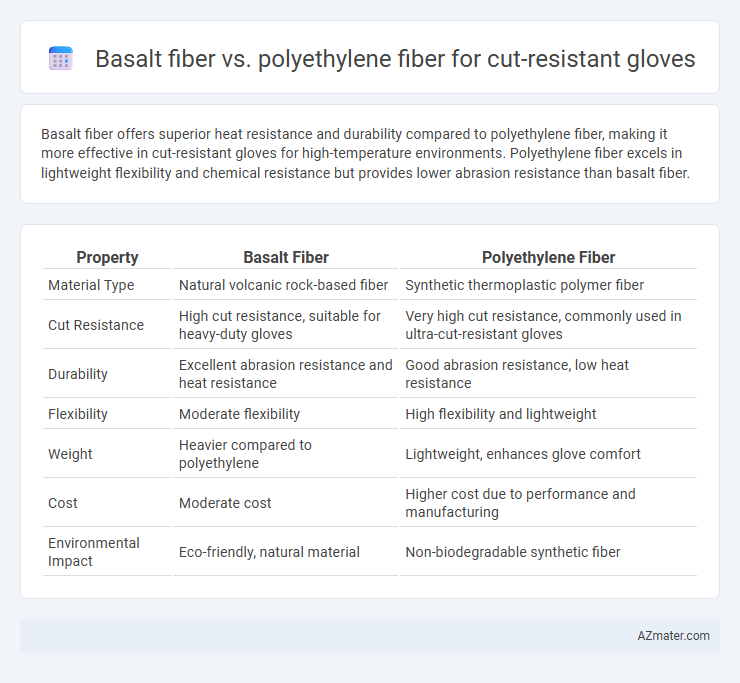Basalt fiber offers superior heat resistance and durability compared to polyethylene fiber, making it more effective in cut-resistant gloves for high-temperature environments. Polyethylene fiber excels in lightweight flexibility and chemical resistance but provides lower abrasion resistance than basalt fiber.
Table of Comparison
| Property | Basalt Fiber | Polyethylene Fiber |
|---|---|---|
| Material Type | Natural volcanic rock-based fiber | Synthetic thermoplastic polymer fiber |
| Cut Resistance | High cut resistance, suitable for heavy-duty gloves | Very high cut resistance, commonly used in ultra-cut-resistant gloves |
| Durability | Excellent abrasion resistance and heat resistance | Good abrasion resistance, low heat resistance |
| Flexibility | Moderate flexibility | High flexibility and lightweight |
| Weight | Heavier compared to polyethylene | Lightweight, enhances glove comfort |
| Cost | Moderate cost | Higher cost due to performance and manufacturing |
| Environmental Impact | Eco-friendly, natural material | Non-biodegradable synthetic fiber |
Introduction to Cut-Resistant Glove Materials
Cut-resistant gloves rely on high-performance fibers to provide protection against sharp objects, with basalt fiber and polyethylene fiber being prominent choices. Basalt fiber offers superior thermal stability and abrasion resistance due to its natural volcanic rock origin, while polyethylene fiber, especially ultra-high-molecular-weight polyethylene (UHMWPE), delivers exceptional cut resistance and lightweight comfort through advanced polymer engineering. Selecting the appropriate material depends on balancing factors such as durability, flexibility, cut resistance ratings, and application-specific requirements in industrial safety.
Overview of Basalt Fiber Properties
Basalt fiber offers exceptional heat resistance up to 980degC, making it ideal for cut-resistant gloves requiring high thermal protection. Its tensile strength ranges between 2,800 and 4,800 MPa, surpassing many synthetic fibers including polyethylene, while maintaining excellent chemical and UV resistance. The natural origin and durability of basalt fiber provide enhanced comfort and longevity in protective glove applications, outperforming polyethylene fibers in both mechanical strength and thermal stability.
Polyethylene Fiber Characteristics
Polyethylene fiber in cut-resistant gloves offers exceptional strength-to-weight ratio, high tensile strength, and superior chemical resistance, making it ideal for durability in harsh industrial environments. Its low moisture absorption and excellent abrasion resistance contribute to longer glove lifespan and consistent cut protection. Compared to basalt fiber, polyethylene provides enhanced flexibility and lighter weight, improving wearer comfort without compromising safety.
Comparative Cut Resistance Performance
Basalt fiber exhibits superior cut resistance compared to polyethylene fiber in cut-resistant gloves due to its higher tensile strength and thermal stability. Basalt fibers can withstand cut levels up to ANSI A7 or higher, while polyethylene fibers typically range between ANSI A3 and A5 levels depending on the density and weave. The enhanced durability and abrasion resistance of basalt fiber gloves make them more suitable for heavy-duty industrial applications requiring prolonged cut protection.
Durability and Longevity: Basalt vs Polyethylene
Basalt fiber exhibits superior durability and longevity in cut-resistant gloves due to its high thermal stability and resistance to abrasion and chemicals, maintaining structural integrity under extreme conditions. Polyethylene fiber, while lightweight and offering excellent cut resistance, tends to degrade faster under UV exposure and high temperatures, which can reduce the glove's lifespan. The inherent toughness of basalt fiber translates to prolonged performance in harsh industrial environments compared to polyethylene fiber's relatively shorter service life.
Comfort and Wearability in Gloves
Basalt fiber offers superior thermal stability and durability, providing enhanced cut resistance without compromising glove comfort, thanks to its inherent breathability and flexibility. Polyethylene fiber is lightweight and offers excellent cut protection but can sometimes lack the same level of comfort due to lower moisture-wicking properties and reduced flexibility. For cut-resistant gloves, basalt fiber typically ensures better wearability through improved heat resistance and ergonomic fit, while polyethylene provides high-performance protection with a slightly stiffer feel.
Thermal Resistance and Safety Implications
Basalt fiber exhibits superior thermal resistance compared to polyethylene fiber, maintaining structural integrity at temperatures exceeding 650degC, while polyethylene fibers typically degrade above 150degC. This high thermal threshold makes basalt fiber gloves more suitable for environments involving extreme heat exposure, significantly reducing burn risks. Consequently, gloves reinforced with basalt fiber enhance safety by providing reliable cut resistance alongside exceptional thermal protection.
Cost Efficiency and Market Availability
Basalt fiber offers superior cut resistance and thermal stability compared to polyethylene fiber, but its higher production cost often limits widespread adoption in cut-resistant gloves. Polyethylene fiber, especially ultra-high-molecular-weight polyethylene (UHMWPE), provides excellent cut protection at a lower cost, making it more cost-efficient and widely available in the market. Manufacturers prioritize polyethylene fiber for large-scale production due to its balance of affordability, availability, and reliable performance in cut-resistant applications.
Environmental Impact and Sustainability
Basalt fiber, made from natural volcanic rock, offers a more eco-friendly alternative with low energy consumption during production and full recyclability, reducing landfill waste in cut-resistant gloves. Polyethylene fiber, particularly ultra-high-molecular-weight polyethylene (UHMWPE), has a higher carbon footprint due to petrochemical processing but benefits from lightweight durability and recyclability under specific conditions. Sustainability in cut-resistant gloves increasingly favors basalt fiber for its renewable sourcing and lower environmental impact compared to petroleum-based polyethylene fibers.
Conclusion: Choosing the Right Fiber for Cut-Resistant Gloves
Basalt fiber offers superior heat resistance and higher tensile strength compared to polyethylene fiber, making it ideal for environments requiring both cut and thermal protection. Polyethylene fiber excels in lightweight comfort and chemical resistance, suited for applications prioritizing dexterity and exposure to harsh chemicals. Selecting the right fiber depends on the specific workplace hazards, balancing protection needs with user comfort and durability.

Infographic: Basalt fiber vs Polyethylene fiber for Cut-resistant glove
 azmater.com
azmater.com